Green Hydrogen Generation by Water Photoelectrolysis: Economic and Environmental Analysis
Abstract
1. Introduction
2. The Green Hydrogen Economy
3. The Photoelectrolysis Technology
4. Literature Review
- No documents when both “economic analysis” and “environmental analysis” were included in the search;
- Six documents when limiting the search to “economic analysis”;
- Fourteen documents when limiting the search to “environmental analysis”.
4.1. Review of the “Economic Analysis” Studies
4.2. Review of the “Environmental Analysis” Studies
4.3. Conclusion on the Literature Review
5. Methodology
5.1. Environmental Analysis
- (1)
- The input materials used within the project for the production of a single cell were determined and quantified in g/cm2 (Table 1).
- (2)
- The materials were searched and transcribed from the IDEMAT 2023 database, as shown in Table 2. In particular, for materials not included in the database, we referred to equivalent materials. For all the materials, the value of the impact, expressed in EUR/kg, has been derived from the database. The value of impact associated with the consumption of electricity is reported in EUR/MJ.
- (3)
- Analogously, for the same materials, the corresponding carbon footprint values expressed in kg CO2-eq./kg (or kg CO2-eq./MJ, for electricity) have been reported.
- (4)
- The material quantities (in kg/cm2) were multiplied by the cell size (e.g., 80 cm2) to obtain the quantity of each material within a single cell (kg).
- (5)
- The amount of material in each cell was multiplied by its environmental impact (EUR/kg) to obtain the total eco-cost (EUR) of the materials used per cell (see Appendix A).
- (6)
- Finally, the value of the “Environmental Cost” in EUR/kg CO2-eq., according to both the EVR and EP methods, was multiplied by the carbon footprint of each element expressed in kg CO2-eq., to obtain the total value in EUR of the environmental cost for producing the cell, according to two different indicators: (a) climate change Eco-costs/Value Ratio, and (b) climate change Environmental Price (see Appendix B).
5.2. Economic Analysis
6. Results and Discussion
6.1. Base Case Results
6.2. Sensitivity Analysis Results
7. Conclusions
- Reduced Costs per Unit of Hydrogen: Higher STH efficiency typically results in greater hydrogen production for the same amount of solar input, thereby lowering costs associated with energy and materials.
- Enhanced Competitiveness: As STH efficiency improves, our process may become more competitive with other hydrogen production methods, making it more attractive for commercial applications.
- Long-term Economic Viability: Sustained advancements in STH efficiency could contribute to the long-term viability of solar-driven hydrogen production within the renewable energy landscape.
Author Contributions
Funding
Data Availability Statement
Acknowledgments
Conflicts of Interest
Abbreviations and Acronyms
| ARERA | Autorità di Regolazione per Energia Reti e Ambiente (Authority for the Regulation of Energy, Networks, and Environment) |
| BEP | Break-even point |
| BTP | Buoni del Tesoro Poliennali (Italian government bonds) |
| CAPEX | Capital expenditure |
| CB | Conduction band |
| CCUS | Carbon Capture, Utilisation and Storage |
| CLCC | Conventional life cycle cost |
| EEA | Electrical energy auto-consumption |
| ELCC | Environmental life cycle cost |
| EN 15804 | European norm 15804 |
| EP | Environmental price |
| EVR | Eco-cost/value ratio |
| FCV | Fuel cell vehicle |
| FEP | Fluorinated ethylene propylene |
| FTO | Fluorine-doped tin oxide |
| GDL | Gas diffusion layer |
| GHG | Greenhouse gas |
| IDEMAT | Industrial Design & Engineering MATerials |
| IEA | International Energy Agency |
| IPCC | Intergovernmental Panel on Climate Change |
| IR | Inflation rate |
| IRAP | Imposta Regionale sulle Attività Produttive (Regional tax on productive activities) |
| IRES | Imposta sul Reddito delle Società (Italian corporate tax) |
| LCC | Life cycle cost |
| LCOH | Levelised Cost of Hydrogen |
| NHE | Normal Hydrogen Electrode |
| NPV | Net present value |
| OCV | Open circuit voltage |
| OPEX | Operational expenditure |
| PEC | Photoelectrochemical cell |
| PEM | Proton exchange membrane |
| PM | Profit margin |
| PPS | Polyphenylene sulphide |
| PTFE | Polytetrafluoroethylene (or Teflon) |
| PV | Photovoltaic |
| PVC | Polyvinylchloride |
| RdS | Ricerca di Sistema Elettrico Nazionale (National Program for Electric System Research) |
| REV | Revenue |
| SETAC | Society of Environmental Toxicology and Chemistry |
| SLCC | Social life cycle cost |
| STH | Solar-to-hydrogen |
| TR | Tax rate |
| TRL | Technology Readiness Level |
| UC | Unsold cells |
| VB | Valence band |
Appendix A
| Unit | Process | Total Eco-Cost (EUR/Unit) | Quantity (Unit) | Total Eco-Cost (EUR) |
|---|---|---|---|---|
| kg | Float glass | 0.2280 | 0.0656 | 1.50 × 10−2 |
| kg | Metalloid oxides | 0.5186 | 2.40 × 10−4 | 1.24 × 10−4 |
| kg | Potassium hydroxide | 0.3183 | 0.0056 | 1.78 × 10−3 |
| kg | Ionomer | 3.2377 | 8.00 × 10−5 | 2.59 × 10−4 |
| kg | Fe2O3 = Other non-metal oxides (n = 2, std. = 0) | 0.1543 | 2.08 × 10−4 | 4.37 × 10−3 |
| kg | Ti = Titanium (primary) | 20.7550 | ||
| kg | P = Non-metal phosphates (n = 1, std. = –) | 0.1120 | ||
| kg | Carbon fibre (95%) | 16.2236 | 8.80 × 10−4 | 1.36 × 10−2 |
| kg | PTFE (Teflon), chemical upcycled (5%) | 1.6762 | ||
| kg | Industrial reverse osmosis water Europe | 0.0027 | 0.0024 | 6.53 × 10−6 |
| kg | PTFE (Teflon), chemical upcycled | 1.6762 | 6.16 × 10−5 | 1.03 × 10−4 |
| kg | PVC (polyvinylchloride emulsion polymerised) | 0.7653 | 0.1424 | 1.09 × 10−1 |
| kg | PPS (polyphenylene sulphide) | 4.5047 | 4.80 × 10−4 | 2.16 × 10−3 |
| kg | Ni = Nickel (primary) | 29.4569 | 6.40 × 10−7 | 2.23 × 10−5 |
| kg | Cu = Copper (primary) | 5.445 | ||
| MJ | PV panel (irradiation 1100 kWh per m2) | 0.0057 | 30.420 | 1.72 × 10−1 |
| TOTAL | 3.19 × 10−1 | |||
Appendix B
| Unit | Process | Carbon Footprint (kgCO2-eq/Unit) | Carbon Footprint (kgCO2-eq) | Climate Change EVR a (EUR) | Climate Change EP b (EUR) |
|---|---|---|---|---|---|
| kg | Float glass | 1.3715 | 9.00 × 10−2 | 1.20 × 10−2 | 5.13 × 10−3 |
| kg | Metalloid oxides | 3.4538 | 8.29 × 10−4 | 1.10 × 10−4 | 4.72 × 10−5 |
| kg | Potassium hydroxide | 1.7839 | 9.99 × 10−3 | 1.33 × 10−3 | 5.69 × 10−4 |
| kg | Ionomer | 11.5819 | 9.27 × 10−4 | 1.23 × 10−4 | 5.28 × 10−5 |
| kg | Fe2O3 = Other non-metal oxides (n = 2, std. = 0) | 0.9644 | 6.45 × 10−3 | 8.57 × 10−4 | 3.67 × 10−4 |
| kg | Ti = Titanium (primary) | 29.5599 | |||
| kg | P = Non-metal phosphates (n = 1, std. = –) | 0.4687 | |||
| kg | Carbon fibre (95%) | 87.8194 | 7.39 × 10−2 | 9.83 × 10−3 | 4.21 × 10−3 |
| kg | PTFE (Teflon), chemical upcycled (5%) | 10.6690 | |||
| kg | Industrial reverse osmosis water Europe | 0.0086 | 2.06 × 10−5 | 2.74 × 10−6 | 1.17 × 10−6 |
| kg | PTFE (Teflon), chemical upcycled | 10.6690 | 6.57 × 10−4 | 8.74 × 10−5 | 3.75 × 10−5 |
| kg | PVC (polyvinylchloride emulsion polymerised) | 2.2200 | 3.16 × 10−1 | 4.20 × 10−2 | 1.80 × 10−2 |
| kg | PPS (polyphenylene sulphide) | 7.1664 | 3.44 × 10−3 | 3.89 × 10−4 | 1.96 × 10−4 |
| kg | Ni = Nickel (primary) | 13.0955 | 1.11 × 10−5 | 1.47 × 10−6 | 6.31 × 10−7 |
| kg | Cu = Copper (primary) | 4.1896 | |||
| MJ | PV panel (irradiation 1100 kWh per m2) | 0.0250 | 7.60 × 10−1 | 1.01 × 10−1 | 4.33 × 10−2 |
| TOTAL | 1.68 × 10−1 | 7.19 × 10−2 | |||
References
- Pang, L.; Liu, L.; Zhou, X.; Hafeez, M.; Ullah, S.; Sohail, M.T. How does natural resource depletion affect energy security risk? New insights from major energy-consuming countries. Energy Strategy Rev. 2024, 54, 101460. [Google Scholar] [CrossRef]
- IEA. Global Hydrogen Review. 2023. Available online: https://www.iea.org/reports/global-hydrogen-review-2023 (accessed on 2 September 2024).
- Ciroth, A.; Hunkeler, D.; Huppes, G.; Lichtenvort, K.; Rebitzer, G.; Rüdenauer, I.; Steen, B. Environmental Life Cycle Costing. In Collaboration with SETAC (Society of Environmental Toxicology and Chemistry); Hunkeler, D., Lichtenvort, K., Rebitzer, G., Eds.; CRC Press: Boca Raton, FL, USA; Taylor & Francis Group: Boca Raton, FL, USA, 2008. [Google Scholar]
- Rodrigues, S.L.; da Silva, E.A. Implementation of environmental life cycle costing: Procedures, challenges, and opportunities. Int. J. Life Cycle Assess. 2024, 29, 803–837. [Google Scholar] [CrossRef]
- Nicita, A.; Maggio, G.; Andaloro, A.P.F.; Squadrito, G. Green hydrogen as feedstock: Financial analysis of a photovoltaic-powered electrolysis plant. Int. J. Hydrogen Energy 2020, 45, 11395–11408. [Google Scholar] [CrossRef]
- Vogtländer, J.G.; Brezet, H.C.; Hendriks, C.F. The virtual eco-costs ’99: A single LCA-based indicator for sustainability and the eco-costs-value ratio (EVR) model for economic allocation. Int. J. Life Cycle Assess. 2001, 6, 157–166. [Google Scholar] [CrossRef]
- De Bruyn, S.; Bijleveld, M.; de Graaff, L.; Schep, E.; Schroten, A.; Vergeer, R.; Ahdour, S. Environmental Prices Handbook EU28 Version; CE Delft: Delft, The Netherlands, 2018. [Google Scholar]
- IDEMAT. Sustainability Impact Metrics. A Spin-Off of the Delft University of Technology. 2023. Available online: https://www.ecocostsvalue.com/ecocosts/ (accessed on 20 June 2024).
- Ashari, P.A.; Oh, H.; Koch, C. Pathways to the hydrogen economy: A multidimensional analysis of the technological innovation systems of Germany and South Korea. Int. J. Hydrogen Energy 2024, 49, 405–421. [Google Scholar] [CrossRef]
- Mbah, R.E.; Wasum, D.F. Russian-Ukraine 2022 War: A review of the economic impact of Russian-Ukraine crisis on the USA, UK, Canada, and Europe. Adv. Soc. Sci. Res. J. 2022, 9, 144–153. [Google Scholar] [CrossRef]
- Albrecht, U.; Bünger, U.; Michalski, J.; Raksha, T.; Wurster, R.; Zerhusen, J.; International Hydrogen Strategies. A Study Commissioned by and in Cooperation with the World Energy Council Germany. 2020. Available online: https://www.weltenergierat.de/wp-content/uploads/2020/10/WEC_H2_Strategies_finalreport.pdf (accessed on 2 September 2024).
- IEA. Global Hydrogen Review. 2021. Available online: https://www.iea.org/reports/global-hydrogen-review-2021 (accessed on 2 September 2024).
- IEA. Global Hydrogen Review. 2022. Available online: https://www.iea.org/reports/global-hydrogen-review-2022 (accessed on 2 September 2024).
- Biden-Harris Administration Announces Awards for up to $2.2 Billion for Two Regional Clean Hydrogen Hubs to Bolster America’s Global Clean Energy Competitiveness and Strengthen Our National Energy Security. Available online: https://www.energy.gov/articles/biden-harris-administration-announces-awards-22-billion-two-regional-clean-hydrogen-hubs#:~:text=As%20part%20of%20President%20Biden's,energy%20product%20that%20can%20be (accessed on 20 February 2025).
- U.S. National Clean Hydrogen Strategy and Roadmap (June 2023). Available online: https://www.hydrogen.energy.gov/docs/hydrogenprogramlibraries/pdfs/us-national-clean-hydrogen-strategy-roadmap.pdf?sfvrsn=c425b44f_5 (accessed on 20 February 2025).
- Locke, K. The urgency of hydrogen: Environmental issues and the need for change. Future Sustain. 2024, 2, 46–58. [Google Scholar] [CrossRef]
- Epstein, P. Hydrogen’s Present and Future in the US Energy Sector. Shearman & Sterling LLP, October 2021. Available online: https://www.shearman.com/en/perspectives/2021/10/hydrogens-present-and-future-in-the-us-energy-sector#:~:text=Approximately%2010%20million%20metric%20tons,U.S.%20hydrogen%20production%20is%20grey (accessed on 2 September 2024).
- World Economic Forum. Green Hydrogen in China: A Roadmap for Progress; White Paper; World Economic Forum: Davos, Switzerland, 2023. [Google Scholar]
- European Commission. REPowerEU Plan—Communication from The Commission to The European Parliament, The European Council, The Council, The European Economic and Social Committee and The Committee of The Regions; European Commission: Luxembourg, 2022. [Google Scholar]
- European Patent Office (EPO) and International Energy Agency. In Hydrogen Patents for A Clean Energy Future; European Patent Office (EPO): Berlin, Germany, 2023.
- Basic Hydrogen Strategy—The Ministerial Council on Renewable Energy, Hydrogen and Related Issues. Available online: https://www.meti.go.jp/shingikai/enecho/shoene_shinene/suiso_seisaku/pdf/20230606_5.pdf (accessed on 20 February 2025).
- World Economic Forum, 2024. Hydrogen is Developing Fast in Japan, Edging Nearer to Wider Use in Society. April 2024. Available online: https://www.weforum.org/agenda/2024/04/hydrogen-japan/ (accessed on 2 September 2024).
- Bristowe, G.; Smallbone, A. The Key Techno-Economic and Manufacturing Drivers for Reducing the Cost of Power-to-Gas and a Hydrogen-Enabled Energy System. Hydrogen 2021, 2, 273–300. [Google Scholar] [CrossRef]
- Miyagawa, T.; Goto, M. Hydrogen Production Cost Forecasts since the 1970s and Implications for Technological Development. Energies 2022, 15, 4375. [Google Scholar] [CrossRef]
- IRENA. Global Hydrogen Trade to Meet the 1.5 °C Climate Goal: Part I—Trade Outlook for 2050 and Way Forward; International Renewable Energy Agency: Abu Dhabi, United Arab Emirates, 2022. [Google Scholar]
- Almaraz, S.; Kocsis, T.; Azzaro-Pantel, C.; Szanto, Z.O. Identifying social aspects related to the hydrogen economy: Review, synthesis, and research perspectives. Int. J. Hydrogen Energy 2024, 49, 601–618. [Google Scholar] [CrossRef]
- Gordon, J.A.; Balta-Ozkan, N.; Haq, A.; Nabavi, S.A. Coupling green hydrogen production to community benefits: A pathway to social acceptance. Energy Res. Soc. Sci. 2024, 110, 103437. [Google Scholar] [CrossRef]
- Maggio, G.; Nicita, A.; Squadrito, G. How the hydrogen production from RES could change energy and fuel markets: A review of recent literature. Int. J. Hydrogen Energy 2019, 44, 11371–11384. [Google Scholar] [CrossRef]
- Squadrito, G.; Maggio, G.; Nicita, A. The green hydrogen revolution. Renew. Energy 2023, 216, 119041. [Google Scholar] [CrossRef]
- Qiao, F. Photoelectrocatalytic hydrogen production: Hydrogen production principle, performance optimization strategy, application and prospect. Nano Res. Energy 2024, 3, e120132. [Google Scholar] [CrossRef]
- Fujishima, A.; Honda, K. Electrochemical photolysis of water at a semiconductor electrode. Nature 1972, 238, 37–38. [Google Scholar] [CrossRef]
- Kudo, A.; Miseki, Y. Heterogeneous photocatalyst materials for water splitting. Chem. Soc. Rev. 2009, 38, 253–278. [Google Scholar] [CrossRef] [PubMed]
- Song, H.; Luo, S.; Huang, H.; Deng, B.; Ye, J. Solar-Driven Hydrogen Production: Recent Advances, Challenges, and Future Perspectives. ACS Energy Lett. 2022, 7, 1043–1065. [Google Scholar] [CrossRef]
- Thangamuthu, M.; Ruan, Q.; Ohemeng, P.; Luo, B.; Jing, D.; Godin, R.; Tang, J. Polymer Photoelectrodes for Solar Fuel Production: Progress and Challenges. Chem. Rev. 2022, 122, 11778–11829. [Google Scholar] [CrossRef]
- Lewis, N.; Nocera, D. Powering the planet: Chemical challenges in solar energy utilization. Proc. Natl. Acad. Sci. USA 2006, 103, 15729–15735. [Google Scholar] [CrossRef]
- Acar, C.; Dincer, I. Investigation of a novel photoelectrochemical hydrogen production system. Chem. Eng. Sci. 2019, 197, 74–86. [Google Scholar] [CrossRef]
- Hisatomi, T.; Kubota, J.; Domen, K. Recent advances in semiconductors for photocatalytic and photoelectrochemical water splitting. Chem. Soc. Rev. 2014, 43, 7520–7535. [Google Scholar] [CrossRef] [PubMed]
- Parkinson, B.; Turner, J. CHAPTER 1: The Potential Contribution of Photoelectrochemistry in the Global Energy Future. In Photoelectrochemical Water Splitting: Materials, Processes and Architectures; Energy and Environment Series; RSC Publishing: London, UK, 2013. [Google Scholar]
- Nozik, A.J. CHAPTER 13: Novel Approaches to Water Splitting by Solar Photons. In Photoelectrochemical Water Splitting: Materials, Processes and Architectures; Energy and Environment Series; RSC Publishing: London, UK, 2013. [Google Scholar]
- Sivula, K.; Grätzel, M. CHAPTER 4: Tandem Photoelectrochemical Cells for Water Splitting. In Photoelectrochemical Water Splitting: Materials, Processes and Architectures; Energy and Environment Series; RSC Publishing: London, UK, 2013. [Google Scholar]
- Wang, J.; Hu, Y.; Toth, R.; Fortunato, G.; Braun, A. A facile nonpolar organic solution process of a nanostructured hematite photoanode with high efficiency and stability for water splitting. J. Mater. Chem. A 2016, 4, 2821–2825. [Google Scholar] [CrossRef]
- Masudy-Panah, S.; Siavash Moakhar, R.; Chua, C.S.; Tan, H.R.; Wong, T.I.; Chi, D.; Dalapati, G.K. Nanocrystal Engineering of Sputter-Grown CuO Photocathode for Visible-Light-Driven Electrochemical Water Splitting. ACS Appl. Mater. Interfaces 2016, 8, 1206–1213. [Google Scholar] [CrossRef]
- Sivula, K.; Le Formal, F.; Grätzel, M. Solar Water Splitting: Progress Using Hematite (α-Fe2O3) Photoelectrodes. ChemSusChem 2011, 4, 432–449. [Google Scholar] [CrossRef]
- Zhang, Y.; Jiang, S.; Song, W.; Zhou, P.; Ji, H.; Ma, W.; Hao, W.; Chen, C.; Zhao, J. Nonmetal P-doped hematite photoanode with enhanced electron mobility and high-water oxidation activity. Energy Environ. Sci. 2015, 8, 1231–1236. [Google Scholar] [CrossRef]
- Ling, Y.; Wang, G.; Wheeler, D.A.; Zhang, J.Z.; Li, Y. Sn-doped Hematite Nanostructures for Photoelectrochemical Water Splitting. Nano Lett. 2011, 11, 2119–2125. [Google Scholar] [CrossRef] [PubMed]
- Lo Vecchio, C.; Trocino, S.; Campagna Zignani, S.; Baglio, V.; Carbone, A.; Díez García, M.I.; Contreras, M.; Gómez, R.; Aricò, A.S. Enhanced Photoelectrochemical Water Splitting at Hematite Photoanodes by Effect of a NiFe-Oxide co-Catalyst. Catalysts 2020, 10, 525. [Google Scholar] [CrossRef]
- Trocino, S.; Lo Vecchio, C.; Campagna Zignani, S.; Carbone, A.; Saccà, A.; Baglio, V.; Gómez, R.; Aricò, A.S. Dry Hydrogen Production in a Tandem Critical Raw Material-Free Water Photoelectrolysis Cell Using a Hydrophobic Gas-Diffusion Backing Layer. Catalysts 2020, 10, 1319. [Google Scholar] [CrossRef]
- Lo Vecchio, C.; Carbone, A.; Trocino, S.; Gatto, I.; Patti, A.; Baglio, V.; Aricò, A.S. Anionic Exchange Membrane for Photo-Electrolysis Application. Polymers 2020, 12, 2991. [Google Scholar] [CrossRef]
- Lo Vecchio, C.; Trocino, S.; Giacoppo, G.; Barbera, O.; Baglio, V.; Díez García, M.I.; Contreras, M.; Gómez, R.; Aricò, A.S. Water Splitting with Enhanced Efficiency Using a Nickel-Based Co-Catalyst at a Cupric Oxide Photocathode. Catalysts 2021, 11, 1363. [Google Scholar] [CrossRef]
- Shen, S.; Lindley, S.A.; Dong, C.-L.; Chen, E.; Lu, Y.-R.; Zhou, J.; Hu, Y.; Wheeler, D.A.; Guo, P.; Zhang, J.Z.; et al. Enhancing Solar-Driven Water Splitting with Surface-Engineered Nanostructures. Solar RRL 2019, 3, 1800285. [Google Scholar] [CrossRef]
- Peerakiatkhajohn, P.; Yun, J.; Wang, S.; Wang, L. Review of recent progress in unassisted photoelectrochemical water splitting: From material modification to configuration design. J. Photonics Energy 2016, 7, 012006. [Google Scholar] [CrossRef]
- Kumar, S.; Ojha, K.; Ganguli, A.K. Interfacial Charge Transfer in Photoelectrochemical Processes. Adv. Mater. Interfaces 2017, 4, 1600981. [Google Scholar] [CrossRef]
- Liu, T.-K.; Jang, G.Y.; Kim, S.; Zhang, K.; Zheng, X.; Park, J.H. Organic Upgrading through Photoelectrochemical Reactions: Toward Higher Profits. Small Methods 2024, 8, 2300315. [Google Scholar] [CrossRef]
- Obata, K.; Schwarze, M.; Thiel, T.A.; Zhang, X.; Radhakrishnan, B.; Ahmet, I.Y.; van de Krol, R.; Schomäcker, R.; Abdi, F.F. Solar-driven upgrading of biomass by coupled hydrogenation using in situ (photo)electrochemically generated H2. Nat. Commun. 2023, 14, 6017. [Google Scholar] [CrossRef] [PubMed]
- Wenderich, K.; Kwak, W.; Grimm, A.; Kramer, G.J.; Mul, G.; Mei, B. Industrial feasibility of anodic hydrogen peroxide production through photoelectrochemical water splitting: A techno-economic analysis. Sustain. Energy Fuels 2020, 4, 3143–3156. [Google Scholar] [CrossRef]
- Gaillard, N.; Deangelis, A. Photoelectrochemical Water Splitting Using Photovoltaic Materials. In Solar to Chemical Energy Conversion. Lecture Notes in Energy; Sugiyama, M., Fujii, K., Nakamura, S., Eds.; Springer: Cham, Switzerland, 2016; Volume 32. [Google Scholar] [CrossRef]
- Frowijn, L.S.F.; Van Sark, W.G.J.H.M. Analysis of photon-driven solar-to-hydrogen production methods in the Netherlands. Sustain. Energy Technol. Assess. 2021, 48, 101631. [Google Scholar] [CrossRef]
- Pinaud, B.A.; Benck, J.D.; Seitz, L.C.; Forman, A.J.; Chen, Z.; Deutsch, T.G.; James, B.D.; Baum, K.N.; Baum, G.N.; Ardo, S.; et al. Technical and economic feasibility of centralized facilities for solar hydrogen production via photocatalysis and photoelectrochemistry. Energy Environ. Sci. 2013, 6, 1983–2002. [Google Scholar] [CrossRef]
- Mandal, K.C.; Das, T.; Das, B.K. Nanomaterials for sustainable water splitting towards green hydrogen production. Int. J. Green Energy 2025, 22, 804–829. [Google Scholar] [CrossRef]
- Karaca, A.E.; Dincer, I. Development and evaluation of a solar based integrated hydrogen energy system for mobile applications. Energy Convers. Manag. 2023, 280, 116808. [Google Scholar] [CrossRef]
- Jeje, S.O.; Marazani, T.; Obiko, J.O.; Shongwe, M.B. Advancing the hydrogen production economy: A comprehensive review of technologies, sustainability, and future prospects. Int. J. Hydrogen Energy 2024, 78, 642–661. [Google Scholar] [CrossRef]
- Percy, A.J.; Edwin, M. A comprehensive review on the production and enhancement techniques of gaseous biofuels and their applications in IC engines with special reference to the associated performance and emission characteristics. Sci. Total Environ. 2024, 934, 173087. [Google Scholar] [CrossRef]
- Abdalla, M.; Abdelrehim, O.; Weic, B.; Wang, X.; Azad, A.K.; Dawood, M.K. Hydrogen production technologies: Conventional processes, Chapter 11. In Hydrogen Economy, 2nd ed.; Processes, Supply Chain, Life Cycle Analysis and Energy Transition for Sustainability; Scipioni, A., Manzardo, A., Ren, J., Eds.; Academic Press: Cambridge, MA, USA, 2023; pp. 381–396. [Google Scholar]
- Qureshi, F.; Tahir, M. Photoelectrochemical water splitting with engineering aspects for hydrogen production: Recent advances, strategies and challenges. Int. J. Hydrogen Energy 2024, 69, 760–776. [Google Scholar] [CrossRef]
- Vilanova, A.; Dias, P.; Lopes, T.; Mendes, A. The route for commercial photoelectrochemical water splitting: A review of large-area devices and key upscaling challenges. Chem. Soc. Rev. 2024, 53, 2388–2434. [Google Scholar] [CrossRef]
- Ghosh, S.; Laha, D.; Kundu, S.; Baduri, S.; Ray, D.; Bhattacharya, C. Optimization of growth condition of n-type Bi2O3 semiconductors for improved photoelectrochemical applications. J. Solid State Electrochem. 2025, 29, 117–128. [Google Scholar] [CrossRef]
- Khan, H.R.; Akram, R.; Aamir, M.; Malik, M.A.; Tahir, A.A.; Choudhary, M.A.; Akhtar, J. Investigations of photoelectrochemical performance of polycrystalline Bi-doped ZnO thin films. J. Phys. Chem. Solids 2023, 181, 111529, ISSN 0022-3697. [Google Scholar] [CrossRef]
- Scharnberg, A.R.D.A.; Berutti, F.A.; Alves, A.K. Visible-light Bi-Fe-Nb-O photoanodes for solar-light driven hydrogen production. Environ. Technol. 2020, 42, 4355–4362. [Google Scholar] [CrossRef]
- Cogal, S.; Oksuz, A.U. Chapter 7—Photoelectrochemical water splitting based on 2D-transition metal dichalcogenide materials. In Nanophotonics, Photoelectrochemical Engineering for Solar Harvesting; Kazim, S., Tahir, M.N., Ahmad, S., Mathur, S., Eds.; Elsevier: Amsterdam, The Netherlands, 2024; pp. 175–209. ISBN 9780323954945. [Google Scholar] [CrossRef]
- Akhter, R.; Hussain, S.; Maktedar, S.S. Advanced graphene-based (photo & electro) catalysts for sustainable & clean energy technologies. New J. Chem. 2024, 48, 437. [Google Scholar] [CrossRef]
- Sharma, P.K.; Hamilton, J.W.J.; Byrne, J.A. Cu clusters modified aligned titania nanotubes for photoelectrochemical water splitting. Mater. Today Proc. 2021, 42, 1766–1771. [Google Scholar] [CrossRef]
- Sharma, R.; Arnoult, K.; Ramasahayam, S.K.; Azam, S.; Hicks, Z.; Shaikh, A. Photoelectrochemical Hydrogen Production Using Novel Heteroatom-Doped Carbon Under Solar Simulated Radiation. In IEEE Transactions on Industry Applications; IEEE: Singapore, 2016; Volume 52, no. 1; pp. 378–383. [Google Scholar] [CrossRef]
- Gulotta, T.M.; Salomone, R.; Mondello, G.; Saija, G.; Lanuzza, F.; Briguglio, N. Life Cycle Assessment and Environmental Life Cycle costing of a unitised regenerative fuel cell stack. Sci. Total Environ. 2023, 901, 166007, ISSN 0048-9697. [Google Scholar] [CrossRef]
- Arfan, M.; Eriksson, O.; Wang, Z.; Soam, S. Life cycle assessment and life cycle costing of hydrogen production from biowaste and biomass in Sweden. Energy Convers. Manag. 2023, 291, 117262. [Google Scholar] [CrossRef]
- Nicita, A.; Squadrito, G.; Maggio, G. Life-cycle cost (LCC) applied to hydrogen technologies: A review. Int. J. Life Cycle Assess. 2024, 29, 46–79. [Google Scholar] [CrossRef]
- Cornes, R.; Sandler, T. The Theory of Externalities, Public Goods, and Club Goods; Cambridge University Press: New York, NY, USA, 1996. [Google Scholar]
- Nguyen, T.L.T.; Laratte, B.; Guillaume, B.; Hua, A. Quantifying environmental externalities with a view to internalizing them in the price of products, using different monetization models. Resour. Conserv. Recycl. 2016, 109, 13–23. [Google Scholar] [CrossRef]
- ARERA—Italian Regulatory Authority for Energy, Networks and Environment. Annual Report 2024 (Relazione Annuale 2024, in Italian), Volume 1. 2024. Available online: https://www.arera.it/fileadmin/allegati/relaz_ann/24/RA24_vol1.pdf (accessed on 2 September 2024).
- MEF—15-Year Italian Government Bonds (BTP) Issued by the Italian Ministry of Economy and Finance, October 2024. Available online: https://www.dt.mef.gov.it/export/sites/sitodt/modules/documenti_it/debito_pubblico/risultati_aste/risultati_aste_btp_15_anni/BTP-15-Anni-Risultati-Asta-11-14.10.2024.pdf (accessed on 20 June 2024).
- ISTAT—Italian National Institute of Statistics. Consumer Prices, Released on 5 January 2023. Available online: https://www.istat.it/wp-content/uploads/2023/01/Consumer-prices_Prov_December2022.pdf (accessed on 9 July 2024).
- ISTAT—Italian National Institute of Statistics. Consumer Prices, Released on 16 January 2024. Available online: https://www.istat.it/wp-content/uploads/2024/01/Consumer-prices_FD_December2023.pdf (accessed on 9 July 2024).
- ISTAT—Italian National Institute of Statistics. Consumer Prices, Released on 7 January 2025. Available online: https://www.istat.it/wp-content/uploads/2025/01/Consumer-prices_Prov_December2024.pdf (accessed on 22 January 2025).
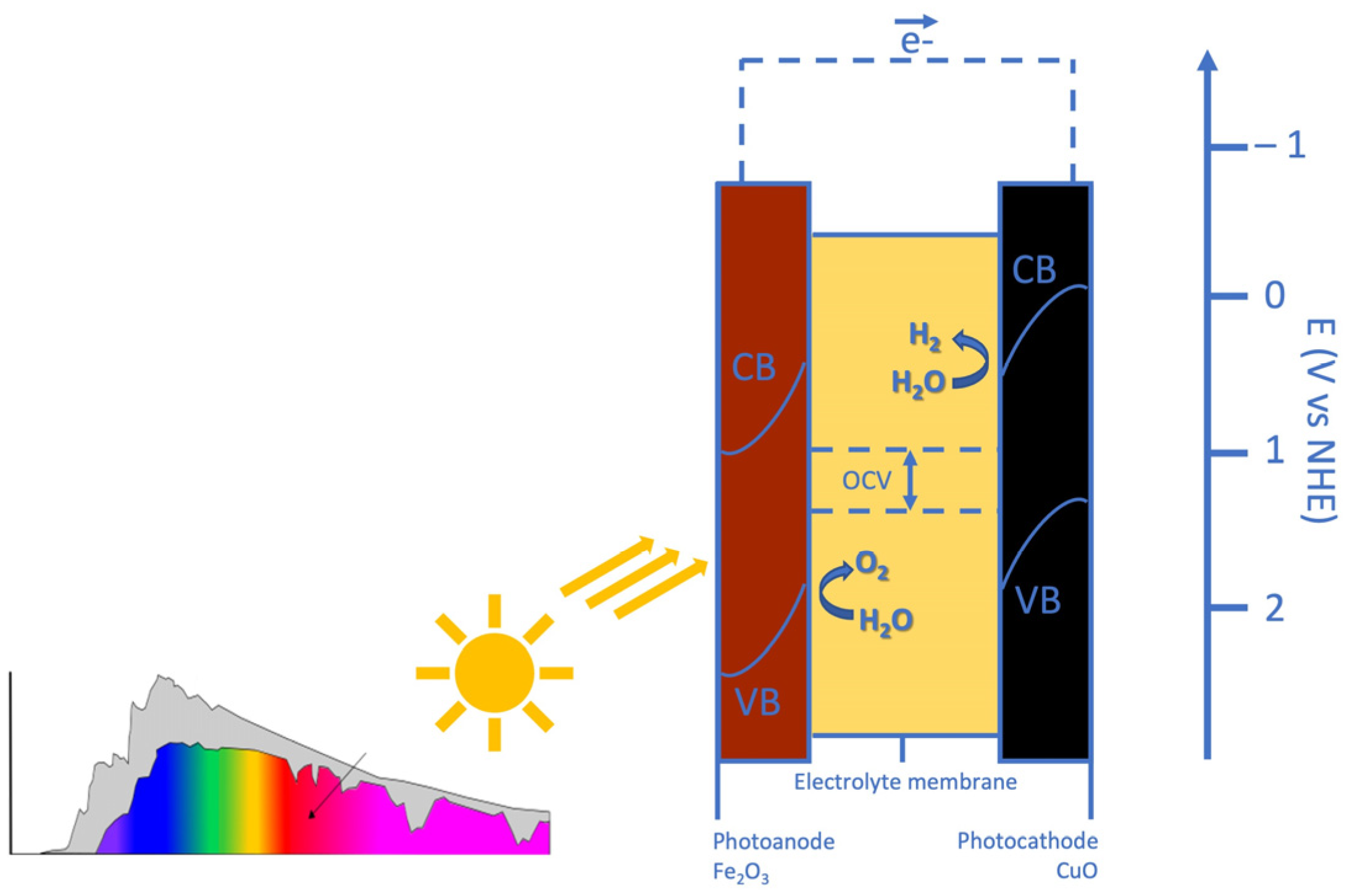
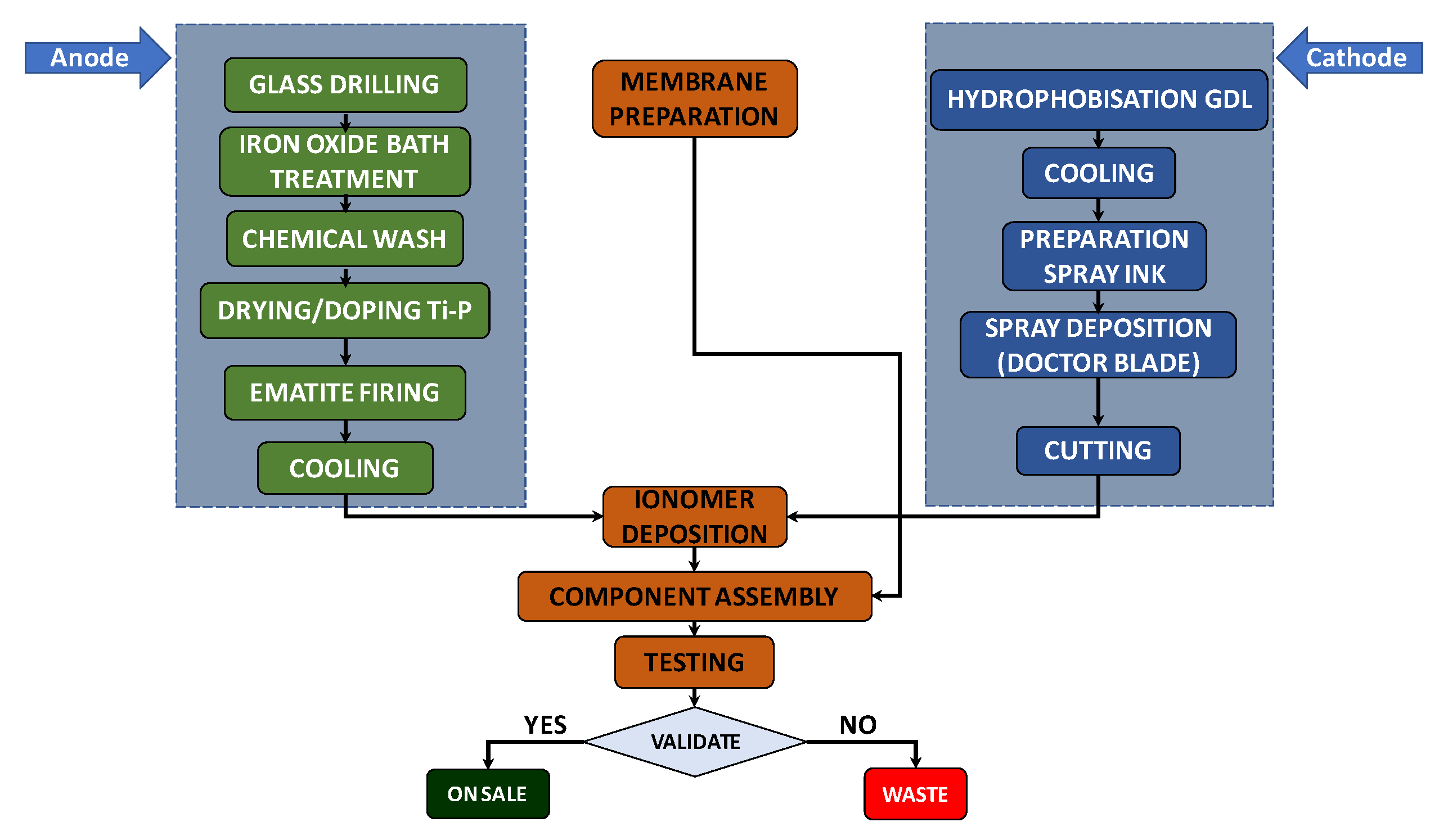
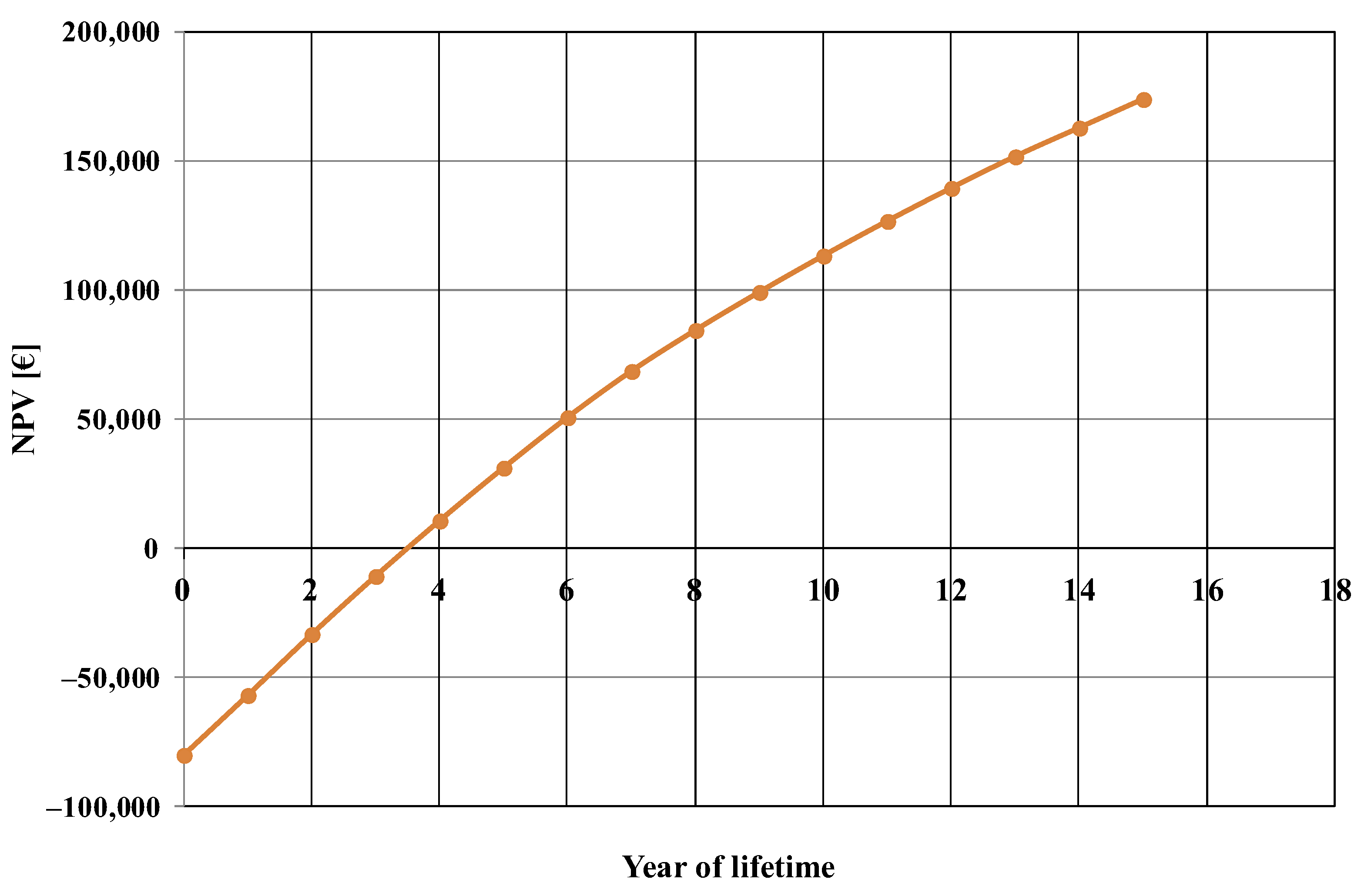
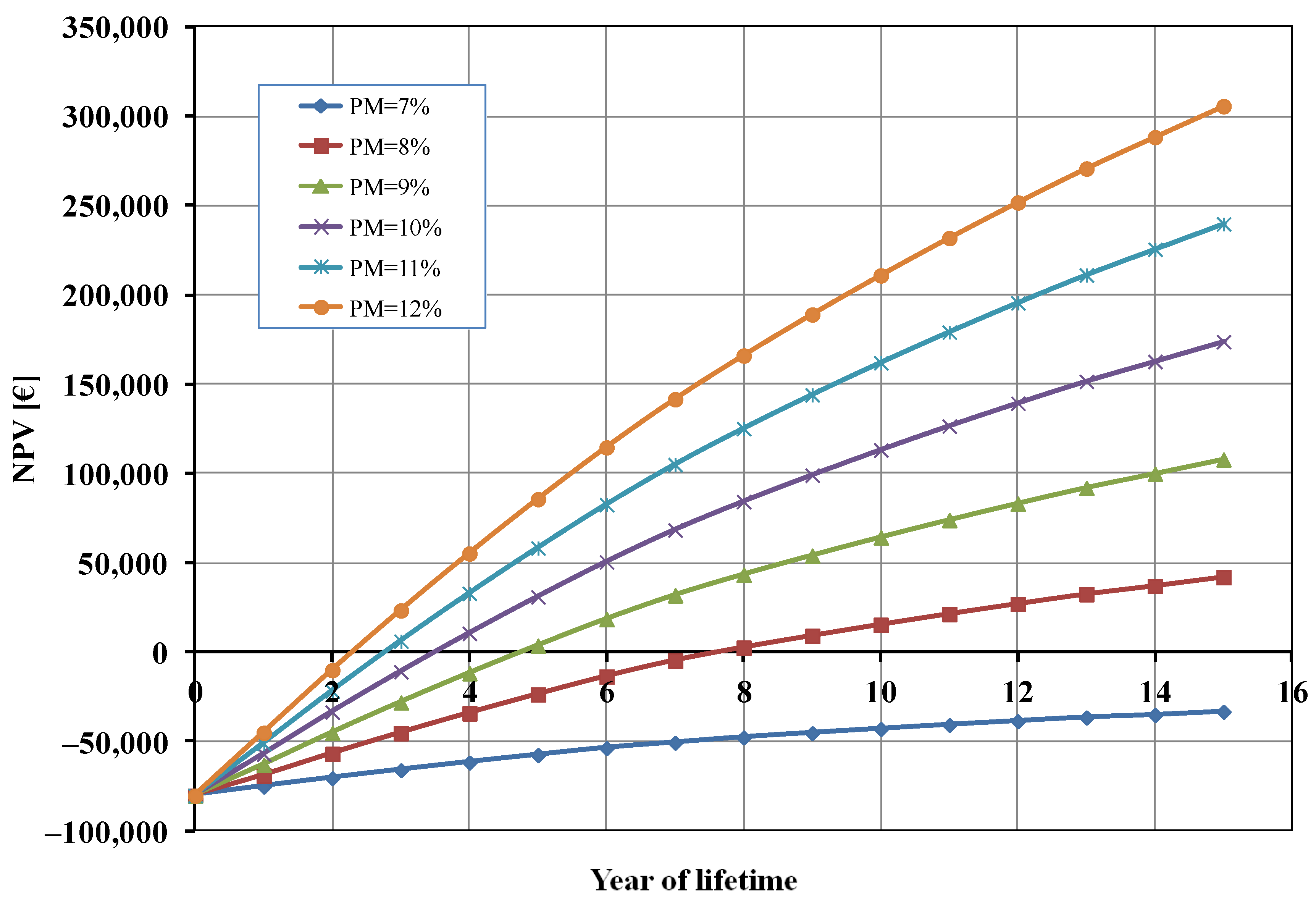
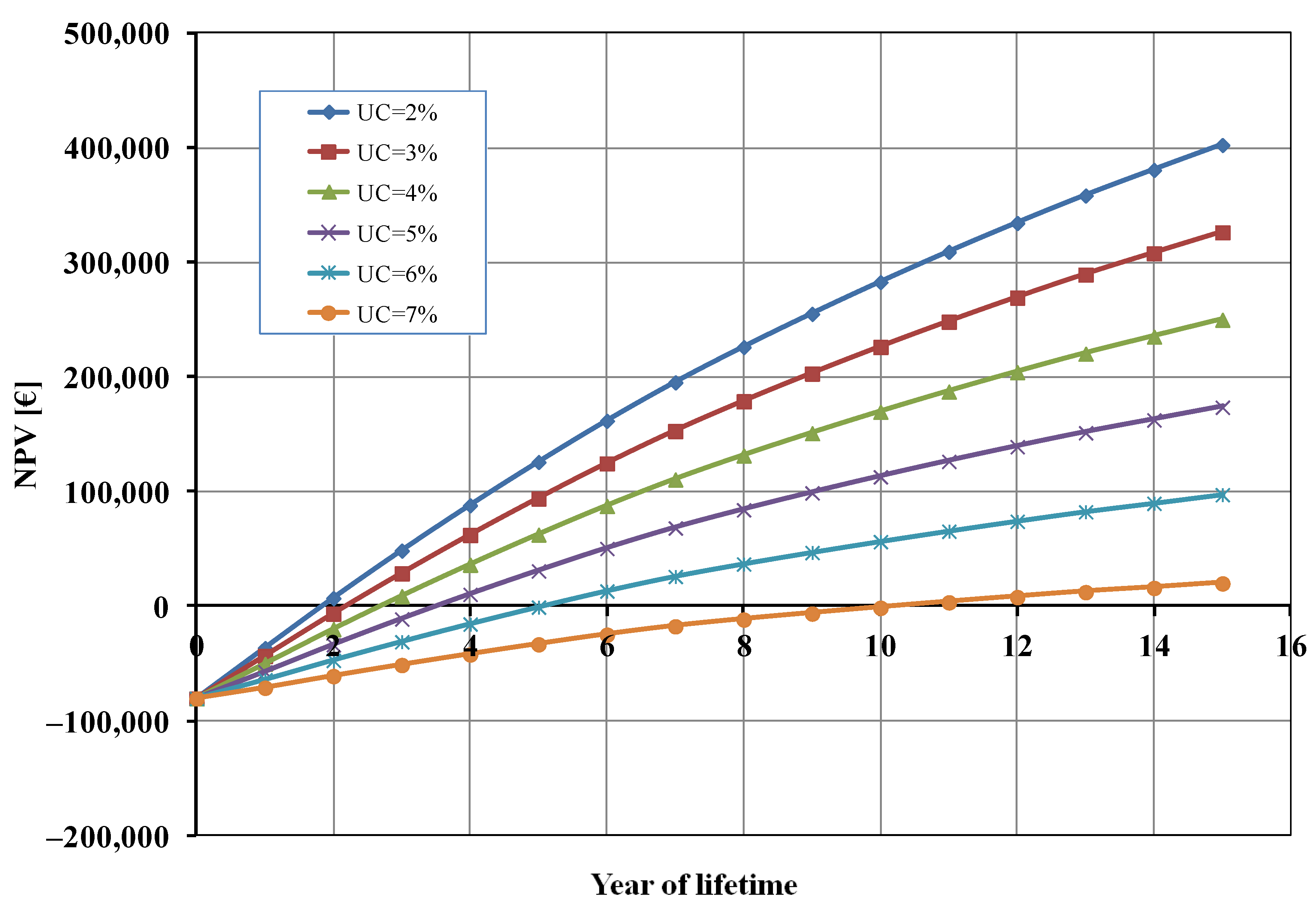
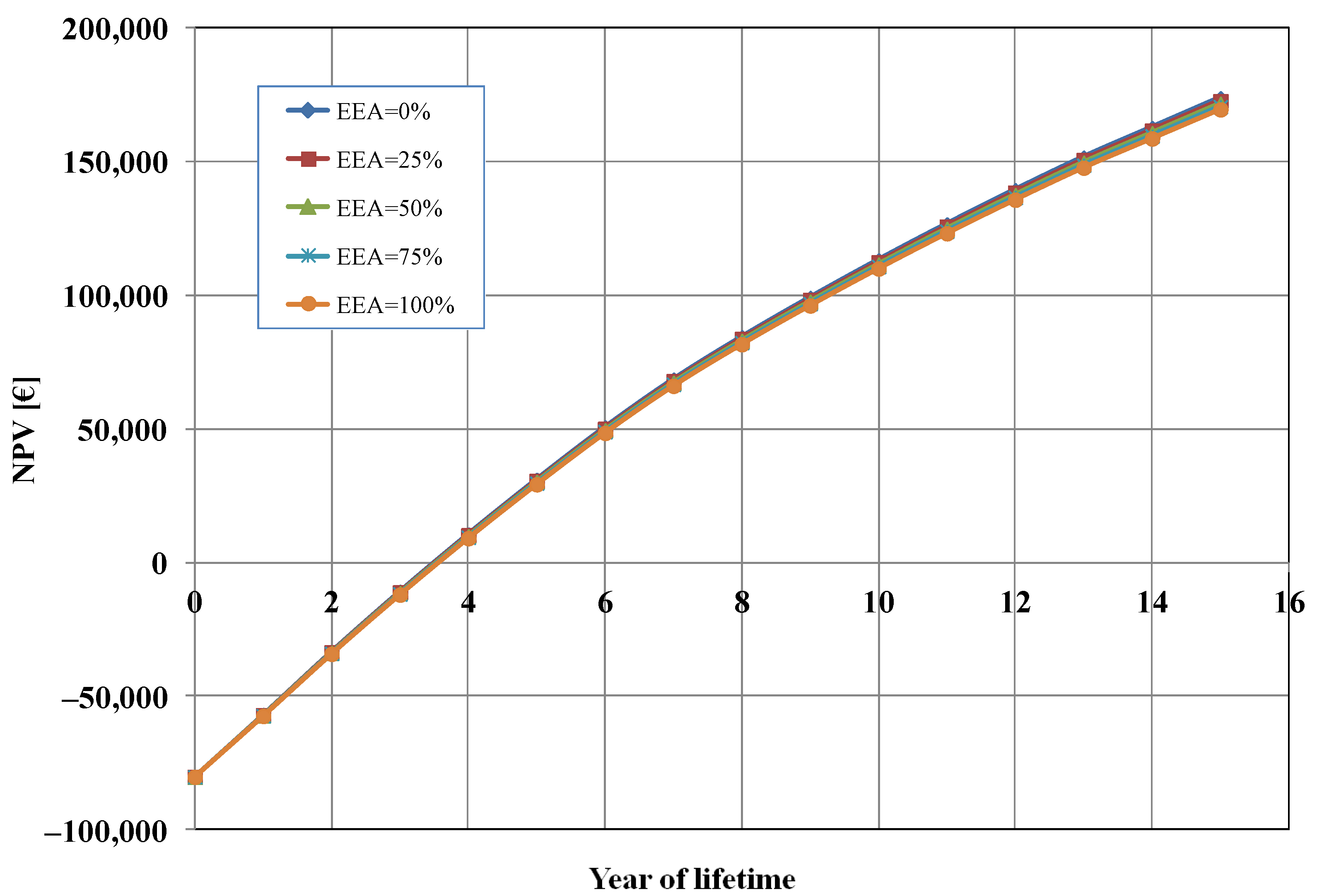

| Input Material | Amount (g/cm2) |
|---|---|
| Glass/FTO | 0.82 |
| CuO | 0.003 |
| Potassium hydroxide | 0.07 |
| Ionomer | 0.001 |
| Fe2O3+Ti+P | 0.0026 |
| Sigracet® 35 BC | 0.011 |
| Distilled water | 0.03 |
| FEP | 7.7 · 10−4 |
| Polyvinylidenfluoride | 1.78 |
| Commercial membrane | 0.006 |
| NiCu | 0.8 · 10−5 |
| Input Material/Resource | Input Material in IDEMAT 2023 |
|---|---|
| Glass/FTO | Float glass |
| CuO | Metalloid oxides |
| Potassium hydroxide | Potassium hydroxide |
| Ionomer | Ionomer |
| Fe2O3+Ti+P | Fe2O3 = Other non-metal oxides (n = 2, std. = 0) Ti = Titanium (primary) P = Non-metal phosphates (n = 1, std. = –) |
| Sigracet® 35 BC | Carbon fibre (95%) PTFE (Teflon), chemical upcycled (5%) |
| Distilled water | Industrial reverse osmosis water Europe |
| FEP | PTFE (Teflon), chemical upcycled |
| Polyvinylidenfluoride | PVC (Polyvinylchloride emulsion polymerised) |
| Commercial membrane | PPS (Polyphenylene sulphide) |
| NiCu | Ni = Nickel (primary) Cu = Copper (primary) |
| Electricity | PV panel (irradiation 1100 kWh per m2) |
| Equipment | Cost (EUR) |
|---|---|
| Solar simulator | 25,000 |
| Electronic instruments | 20,000 |
| Tower oven (25 kW) | 18,000 |
| Little tower oven (15 kW) | 10,000 |
| Ultrasound bath | 1000 |
| Heating plate | 500 |
| Automated drill press X-Y | 5500 |
| CAPEX: | 80,000 |
| Item | Cost (EUR/y) |
|---|---|
| Materials | 852,615 |
| Labour | 60,000 |
| Electricity consumption | 12,338 |
| Other | 1500 |
| OPEX: | 926,453 |
| Approach | External Cost (EUR/y) |
|---|---|
| Total eco-costs | 1416 |
| Climate change EVR | 745 |
| Climate change EP | 319 |
| Approach | CAPEX | OPEX | External Costs |
|---|---|---|---|
| Total eco-costs | 7.94% | 91.92% | 0.14% |
| Climate change EVR | 7.94% | 91.98% | 0.07% |
| Climate change EP | 7.95% | 92.02% | 0.03% |
Disclaimer/Publisher’s Note: The statements, opinions and data contained in all publications are solely those of the individual author(s) and contributor(s) and not of MDPI and/or the editor(s). MDPI and/or the editor(s) disclaim responsibility for any injury to people or property resulting from any ideas, methods, instructions or products referred to in the content. |
© 2025 by the authors. Licensee MDPI, Basel, Switzerland. This article is an open access article distributed under the terms and conditions of the Creative Commons Attribution (CC BY) license (https://creativecommons.org/licenses/by/4.0/).
Share and Cite
Maggio, G.; Vasta, S.; Nicita, A.; Trocino, S.; Giorgianni, M. Green Hydrogen Generation by Water Photoelectrolysis: Economic and Environmental Analysis. Energies 2025, 18, 1439. https://doi.org/10.3390/en18061439
Maggio G, Vasta S, Nicita A, Trocino S, Giorgianni M. Green Hydrogen Generation by Water Photoelectrolysis: Economic and Environmental Analysis. Energies. 2025; 18(6):1439. https://doi.org/10.3390/en18061439
Chicago/Turabian StyleMaggio, Gaetano, Salvatore Vasta, Agatino Nicita, Stefano Trocino, and Mauro Giorgianni. 2025. "Green Hydrogen Generation by Water Photoelectrolysis: Economic and Environmental Analysis" Energies 18, no. 6: 1439. https://doi.org/10.3390/en18061439
APA StyleMaggio, G., Vasta, S., Nicita, A., Trocino, S., & Giorgianni, M. (2025). Green Hydrogen Generation by Water Photoelectrolysis: Economic and Environmental Analysis. Energies, 18(6), 1439. https://doi.org/10.3390/en18061439








